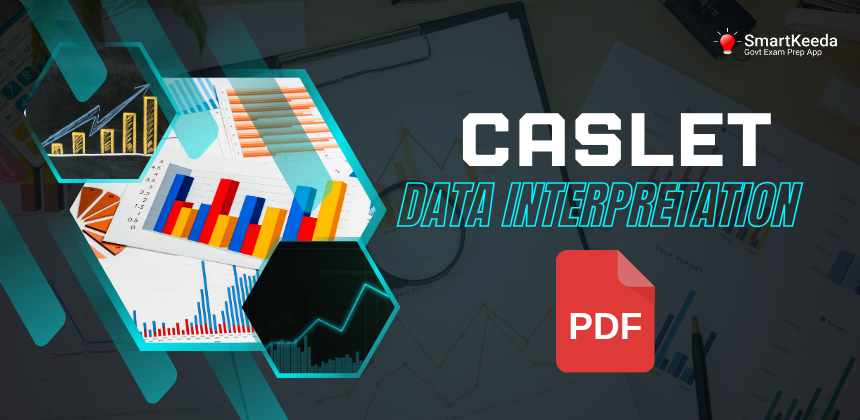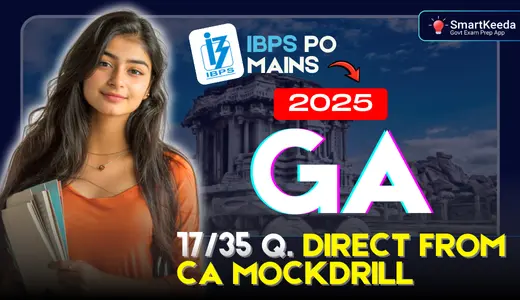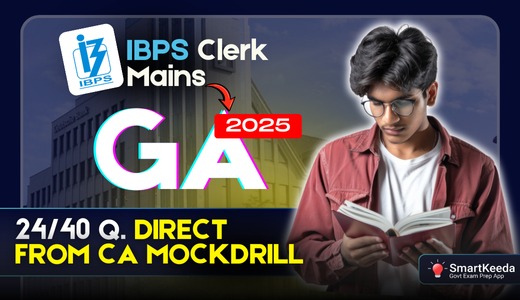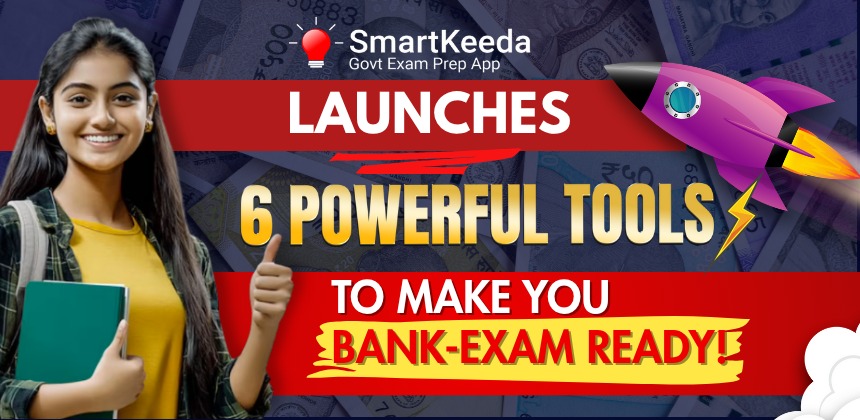Caselet DI Questions & Answers with PDF | Learn How to Solve Caselet DI Fast

Hello Aspirants,
In this article “Caselet DI”, we discuss all the information regarding caselet data interpretation, and it's types and their importance in all the government exams like SBI PO, IBPS PO, LIC, NIACL, IBPS Clerk, SBI Clerk, RRB Scale 1, and RRB Office Assistant.
What is Caselet DI-
In short form, Caselet DI is a piece of information in the form of a paragraph followed by five questions and given without any table or chart. In other words, we can say Caselet Data Interpretation is a set of information which is present in the form of passage. In a Caselet DI, there will not be any table or graphs are provided. You have to read the data or given information and draw a table chart or organise the given data to solve the questions.
How to Solve Caselet DI-
While solving Caselet Data Interpretation Questions involves the use of basic formulas and manipulation of numbers. For Bank and Insurance Exams you need to brush up your calculation skills; you need to perform calculations faster and accurately than others. Once you become a master of calculation you can solve Caselet DI Questions in just three to four minutes easily.
Caselet DI PDF -
You can download Caselet DI pdf so you can practice Caselet Data Interpretation offline. Here are the ten Caselet di quizzes pdf you can download by just clicking the link below.
Caselet DI PDF Quiz 1
Caselet DI PDF Quiz 2
Caselet DI PDF Quiz 3
Caselet DI PDF Quiz 4
Caselet DI PDF Quiz 5
Caselet DI PDF Quiz 6
Caselet DI PDF Quiz 7
Caselet DI PDF Quiz 8
Caselet DI PDF Quiz 9
Caselet DI PDF Quiz 10
Types of Caselet DI-
Generally, Caselet DI based on Simple Interest, Boats and Stream, Profit and Loss, Partnership, Venn diagram, Time and Work, Probability, Percentage and pipe and cistern. Here we will discuss different “Types of Caselet DI” with examples, as you can see below:
Caselet DI Based on Percentage:

Three friends Seeta, Reeta and Geeta spends 12%, 14% and 16% of their monthly salary on travelling in the given order and each of them save half of the remaining amount. The monthly salary of Seeta and Geeta is same and the monthly saving of Seeta is Rs. 360 more than that of Geeta. The total expenditures of Seeta and Reeta together on travelling is Rs. 1240 more than that of Geeta.
Questions :
1. What is the monthly expenditure of Seeta and Reeta together on travelling?
A. Rs. 4240 B. Rs. 4120 C. Rs. 3890 D. Rs. 4480 E. None of these
2. The monthly salary of Reeta is how much more than/less than that of Seeta?
A. Rs. 0 B. Rs. 3000 more C. Rs. 4000 more D. Rs. 3000 less E. Rs. 4000 less
3. What is the sum of the saving of all the three friends together?
A. Rs. 21500 B. Rs. 22480 C. Rs. 24000 D. Rs. 20800 E. None of these
4. The total monthly saving of three friends together is what percentage of their total monthly salary?
A. 42% B. 44% C. 41% D. 43% E. None of these
5. By how much should Seeta's monthly salary be increased so the monthly expenditures of Seeta on travelling will become equal to that of Geeta?
A. Rs. 4000 B. Rs. 6000 C. Rs. 8000 D. Rs. 3600 E. None of these
Correct Options :
1 |
2 |
3 |
4 |
5 |
|
B |
E |
A |
D |
B |
Click here for the Explanation
Caselet DI Based on Average: Virat kohli scored runs against different countries in three different years.
NOTE: Total runs scored in a year= Australia + England + Others
2015: The total runs scored in 2015 were 1200. The runs scored against England were 1/3rd of the runs against Others in 2016. The average runs scored against Australia and England was 300.
2016: The total runs scored against Australia and Others was 1200. The ratio of the total runs scored against Others in 2015 to that of the total runs scored against Others in 2016 is 4:3. The total runs scored against England in 2016 were equal to the total runs scored against England in 2017.
2017: The sum of the total runs scored against Australia and England is equal to the total runs scored against Others. The total runs scored in 2017 were 1400. The total runs scored against Australia were twice of the runs scored against England in 2015.
Questions:
6. What were the total runs scored in 2016?
A. 1100 B. 1500 C. 1600 D. 1400 E. 1000
7. What is the sum of the runs scored against England in all three years?
A. 800 B. 950 C. 850 D. 1050 E. 1100
8. What is the ratio of the total runs scored against Australia in 2015 to that of the total runs scored against England in 2017?
A. 7 : 9 B. 9 : 7 C. 11 : 7 D. 9 : 8 E. 11 : 13
9. What is the difference between the total runs scored against Others in 2015 to the total runs scored against Others in 2016?
A. 150 B. 200 C. 100 D. 300 E. 250
10. The total runs scored against Australia in 2016 is what percentage of the total runs scored against Australia in 2017?
A. 125% B. 100% C. 150% D. 200% E. 250%
Correct Options :
6 |
7 |
8 |
9 |
10 |
|
C |
B |
D |
A |
E |
Click here for the Explanation
Caselet DI Based on Time and Distance:

In an amusement park, the following types of traffic signals are there to drive a toy car.
Red Light (R) = Stop
Yellow light (Y) = Wait
Red and Yellow lights (RY) = Turn left
Red and Green lights (RG) = Turn right
Yellow and Green lights (YG) = Go at 20 km per hour
Red, Yellow, and Green lights (RYG) = Go at 10 km per hour
Green light (G) = Go at 5 km per hour
All children driving the cars inside the amusement park should compulsorily follow the traffic signals and can’t go outside the park to drive the car. A girl Ankita who is facing north, drive the car at the speed of 30 km per hour inside the park and encounters the signals in the following manners. (She can go to the next signal only after passing the previous signal)
Starting Point = S
After half an hour, 1st signal – RY and YG
After 15 minutes, 2nd signal – RYG
After 30 minutes, 3rd signal – RG and RYG
After 15 minutes, 4th signal – RG and YG
After an hour, 5th signal – RY and G
After 2 hours, 6th signal – R
Questions:
11. What is the total distance that Ankita travelled from the starting point till the 6th signal?
A. 55 km B. 52.5 km C. 57.5 km D. 62.5 km E. None of these
12. What is the average speed at which Ankita travelled from the starting point till the 6th signal?
A. 12 7/9 km per hour B. 11 7/9 km per hour C. 12 5/9 km per hour D. 11 5/9 km per hour E. None of these
13. Suppose, in park there is no signals then how much less time Ankita would have taken to reach the final position?
A. 3 hours 12 minutes B. 3 hours 32 minutes C. 2 hours 12 minutes D. 3 hours 58 minutes
E. 4 hours 5 minutes
14. If at the starting point, Ankita was facing toward south then what would be the final position from the starting point?
A. 27.5 km towards south and 10 km towards east B. 17.5 km towards south and 12.5 km towards east
C. 27.5 km towards north and 10 km towards east D. 27.5 km towards south and 10 km towards west
E. 17.5 km towards north and 10 km towards east
15. After the starting point, if the first signal was RG and RYG instead of RY and YG then what would be the final position of Ankita from the starting point?
A. 17.5 km towards west and 10 km towards north B. 12.5 km towards west and 2.5 km towards north
C. 12.5 km towards west and 10 km towards north D. 12.5 km towards east and 2.5 km towards south
E. 17.5 km towards east and 10 km towards south
Correct options:
|
11 |
12 |
13 |
14 |
15 |
|
C |
A |
B |
D |
B |
Click here for the Explanation
High Level Caselet DI Based on Percentage:
One day, in an SBI Branch the attendance of all the employees was 100% but all the employees were not punctual to the office nor did all the employees stayed till the end of the office time. On that day, of all the employees who arrived early at the office, 20% of them left early but 40% of them left late and rest of them left on time. Of the employees who arrived late at the office, 50% of them left late but 25% of them left on time and rest of them left early. Of the employees who arrived on time, 37.5% of them left early and an equal number of them left late but rest of them left on time. The number of employees who arrived early was equal to the number of employees who left on time and the number of employees who left early was 39 more than the number of employees who arrived late at the office. The number of employees who didn’t leave on time was 144.
Questions:
16. What is the difference between the total number of employees who left early and the total number of employees who left late?
A. 18 B. 16 C. 20 D. 22 E. None of these
17. What is the total number of employees working in that branch?
A. 208 B. 212 C. 204 D. 210 E. None of these
18. Find the respective ratio of the number of employees who arrived early, the number of employees who arrived on time, and the number of employees who arrived late?
A. 5 : 10 : 2 B. 5 : 8 : 4 C. 10 : 9 : 8 D. 5 : 8 : 5 E. None of these
19. Suppose on the day before yesterday of that day 25% of the total number of employees was on leave on the medical ground and 33.33% of the remaining was on leave for personal reason then how many employees was present on the day before yesterday of that day?
A. 51 B. 102 C. 119 D. 65 E. None of these
20. The total number of employees who left on time was how much percent more than/less than the total number employees who didn’t leave on time?
A. 75% B. 80% C. 58.33% D. 58.50% E. 75.50%
Correct options:
|
16 |
17 |
18 |
19 |
20 |
|
A |
C |
A |
B |
C |
Click here for the Explanation
High Level Caselet DI Based on Speed and Distance: Ram goes to a hill station by car. While going upwards (uphill) the consumption of petrol was increased by 25% of the normal consumption of petrol but while going downwards (downhill) the consumption of petrol was decreased by 50% of the normal consumption of petrol. He goes from the point A to the point B. The total distance between point A and point B is 525 km in which the total distance travelled by him uphill is 2.5 times of the total distance travelled by him downhill and the total distance travelled by him on the plane surface is 140 km. While coming back from the point B to point A, he saves 15 litres of petrol and the consumption of petrol is normal on plane surface.
21. What is the mileage of the car on downhill?
A. 1 litre per 10 kilometers B. 1 litre per 15 kilometers C. 1 litre per 17.5 kilometers
D. 1 litre per 15.5 kilometers E. None of these
22. If point A to point B were a plane surface then how many litres of petrol he would have consumed more while going and coming back?
A. 12 litres B. 18.33 litres C. 15.33 litres D. 11.67 litres E. 12.67 litres
23. The quantity (in litres) of petrol consumed for the entire journey (from point A to point B and from point B to point A) is
A. 114.4 litres B. 145.2 litres C. 120.4 litres D. 110.5 litres E. 115.6 litres
24. If the speed of car is 55 km per hour on the plane surface and while going uphill, the car’s speed was decreased by 25% of the normal speed and while going downhill the car’s speed was increased by 50% of the normal speed then approximately how much time he would have taken during the entire journey? (if he returns immediately from point B to point A)
A. 21.09 hours B. 19.09 hours C. 19.90 hours D. 21.10 hours E. 21.90 hours
25. What is the difference between the mileage of car on downhill and that on uphill?
A. 1 litres per 33 kilometres B. 1 litres per 22 kilometres C. 1 litres per 11 kilometres
D. 1 litres per 9 kilometres E. 1 litres per 10 kilometres
Correct options:
|
21 |
22 |
23 |
24 |
25 |
|
E |
D |
E |
B |
C |
Click here for the Explanation
Caselet DI Based on Simple Interest and Compound Interest:

Krishna invested some money under 20% per annum simple interest in Axis bank. At the end of one – year, he withdrew all amount from the Axis bank and invested in Bandhan bank at the rate of R % per annum under compound interest compounded annually for two years and received Rs. 57600 as total interest from the Bandhan bank. The first year’s interest at Bandhan bank was Rs. 24000.
26. In starting, how much money had Krishna invested in Axis bank?
A. Rs. 60000 B. Rs. 75000 C. Rs. 10000 D. Rs. 50000 E. None of these
27. Total how much interest did Krishna get from the Axis bank and the Bandhan bank together?
A. Rs. 68600 B. Rs. 67600 C. Rs. 64600 D. Rs. 71200 E. None of these
28. If the rate of interest was interchanged i.e. Axis bank had offered R% per annum simple interest and Bandhan bank had offered 20% per annum compound interest then how much less money Krishan would have received at the end of 3 years?
A. Rs. 16800 B. Rs. 15800 C. Rs. 14800 D. Rs. 16400 E. None of these
29. If Krishan had invested the sum of money only in Axis bank for 3 years under 20% per annum simple interest then at the end of 3 years, total how much simple interest he would have received from the Axis bank?
A. Rs. 25000 B. Rs. 30000 C. Rs. 40000 D. Rs. 20000 E. None of these
30. If the first year’s interest at Bandhan bank was same as the simple interest received from the Axis bank at the end of 1 year and the rate of interest for the Bandhan bank remained constant then what should be the rate of interest for Axis bank?
A. 40% B. 50% C. 66 2/3 % D. 66 2/5 % E. 43 2/5 %
Correct options:
|
26 |
27 |
28 |
29 |
30 |
|
D |
B |
A |
B |
C |
Click here for the Explanation
Caselet DI Based on Profit and Loss:

Image4 ALT Text: caselet di based on profit and loss, new pattern based caselet di, caselet di for sbi po pdf, caselet di for sbi po 2019 pdf, caselet di pdf download for sbi po 2019, caselet di pdf for sbi po pre 2019, caselet di asked in sbi po 2018, caselet di for sbi po 2019, caselet questions for sbi 2019,
Three friends, Chand, Chandni, and Chanchal went to a shopping centre. Each of them had Rs. 2500. In the shopping centre, the session sale discount was 10% on the marked price. Chandni and Chanchal were regular customers so they got 20% each an additional discount on the discounted price but Chand being a new customer didn’t get any additional discount. Only Chanchal had a membership card of the shopping centre which gave an additional discount of 25% on the discounted price. They all like Juicers of xyz brand and they purchased one piece each of that brand. The marked price of each piece was same. In last, when they calculated then they found that Chandni had paid Rs. 360 more than that of Chanchal.
31. If all of them combine the money paid for Juicer then, the total money paid by them for three pieces of the juicers was what percentage of the total marked price of the three juicers?
A. 62% B. 72% C. 78% D. 68% E. None of these
32. The amount paid by Chand for the juicer was how much more than that by Chanchal?
A. 45% B. 50% C. 55.33% D. 66.67% E. None of these
33. What is the ratio of the amount paid by Chand to that by Chanchal?
A. 9 : 7 B. 3 : 2 C. 6 : 5 D. 5 : 3 E. None of these
34. How much money was left with Chand after purchasing the juicer?
A. Rs. 900 B. Rs. 500 C. Rs. 700 D. Rs. 750 E. None of these
35. What was the marked price of the juicer?
A. Rs. 1800 B. Rs. 2400 C. Rs. 2000 D. Rs. 2150 E. None of these
Correct options:
|
31 |
32 |
33 |
34 |
35 |
|
B |
D |
D |
C |
C |
Click here for the Explanation
We hope this article cleared your all thought regarding Caselet DI, if you still have any doubt regarding Caselet Data Interpretation please feel free to contact us at help@smartkeeda.com.
Happy Learning J and Keep Practicing soon you will achieve your goal.
Regards,
Team Smartkeeda
For Caselet DI Quizzes Click Here
Free SBI PO 2019 Mock Test Click Here..
Free LIC AAO 2019 Mock Test Click Here..








